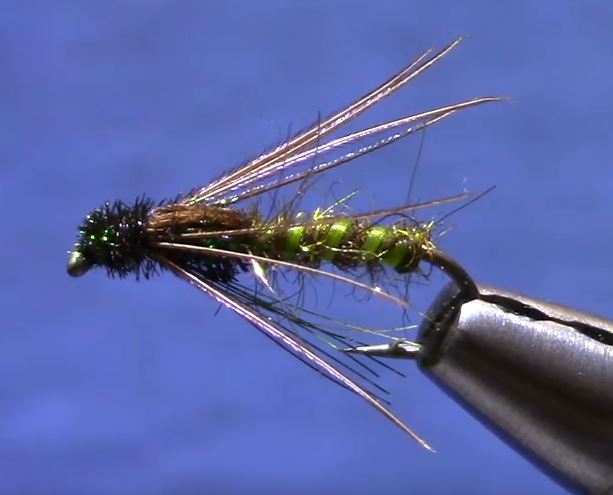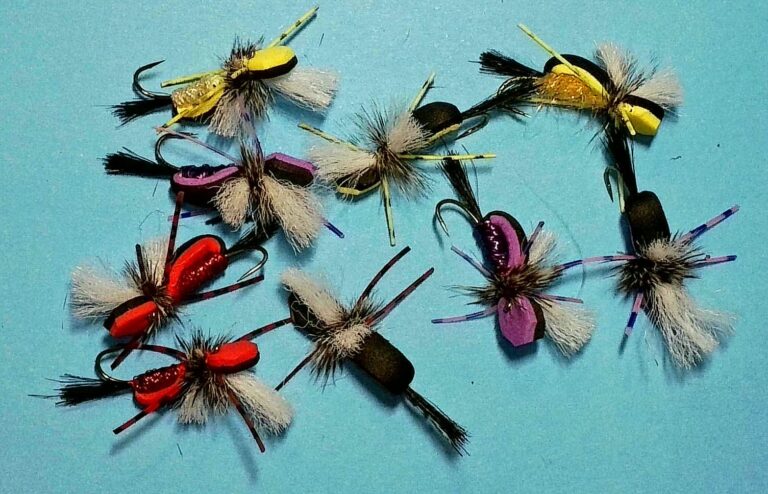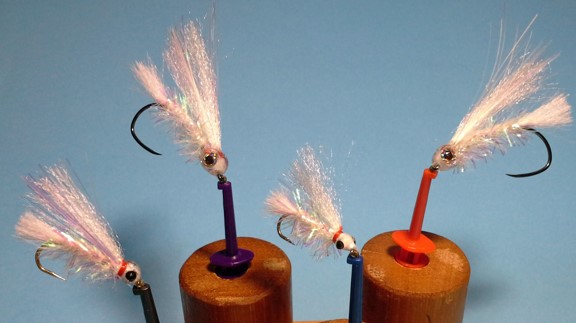This pattern was originally tied to be suggestive as a Stillwater Caddis attractor. This version has a green rib used to suggest segmentation, and a Pheasant Tail Soft Hackle. The Peacock Herl thorax gives this fly some natural iridescent qualities and the UV lime green butt and rib give it a little extra flash.
Materials
- Hook – 3x long shank hook size 12 to 8 (We will use size 10)
- Thread – Light olive
- Rib – Lime green DMC Embroidery Thread E990
- Body – Olive brown Hare’s Ear plus dubbing
- Shellback – Ringneck Pheasant tail fibres
- Thorax – Peacock herl
- Soft Hackle – Pheasant body feather
- Head – Peacock herl
Preparing a Soft Hackle Feather
- Strip all the fluffy bits from both sides of the feather.
- Strip off the other fibres until the longest fibre is about the length of the hook.
- Place hackle pliers over the tip off the feather on the middle vein of the feather. Fold all the loose fibres back away from the pliers.
- Remove the pliers and cut the tip so you leave a small triangle of feather to use for tying in the feather onto the hook.
Tying Instructions
- Crush barb and cover hook with thread
- Tie in the ribbing material
- Make a dubbing loop. Wax the thread and create a dubbing brush with Hare’s ear plus dubbing. Moisten fingers and tighten finished loop. Dub the hook to the three quarter mark.
- Cut ten to fifteen fibres from a Pheasant tail feather. Even the ends. Tie them in for the shellback by the thick end. Tie thread back to the one third mark of the hook.
- Take four or five peacock herls and tie them in to create the thorax. Wind back to the three quarter mark of the hook.
- Prepare Pheasant body feather and tie it in (see above). Three of four wraps and tie it off. Fold all the fibres back and wrap the thread so they are all pointing to the rear of the fly.
- Fold the Pheasant tail fibres over the peacock herl and soft hackle to create the shell back. Tie it off
- Tie in two peacock herl fibres and create the head with two or three turns. And tie it off
- Whip finish and coat shell back and tie off point with Sally Hansen’s.

How to Fish
Caddis Pupae swim in short wavy movements and then pause until they contact a rock or reed etc. They then climb out of the water onto the item to hatch. Cast wait 10-15 seconds for the fly slowly sink into the water.
Figure 8 strips or 6 to 8 inch slow strips. This will make the fly to swim slowly rising towards the surface. Pause 2-3 seconds every 5-6 strips
Brian Chan Stillwater Caddis Pupa
From flyGuys.net
Materials
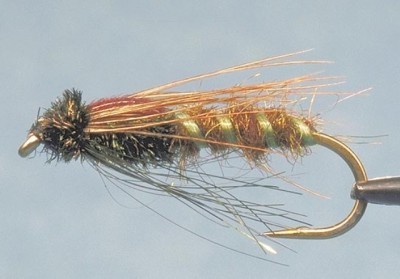
- Hook: Tiemco 200R size 8 – 12
- Thread: Olive 8/0
- Rib: Lime green super floss
- Body: Arizona synthetic peacock dubbing
- Wing case: Pheasant tail
- Thorax: Peacock herl
- Legs: Pheasant tail fibres
- Beard: Peacock angel hair
- Head: Peacock herl
Tying Instructions
- Wind the thread onto the hook and tie in a piece of the lime green super floss.
- Dub in the Arizona synthetic peacock and form the abdomen to 3/4 of the hook shank.
- Counter wind the rib over the body and secure.
- Tie in the wing case back over a small portion of the abdomen.
- Add in 2 – 3 strands of peacock herl by the tips and wind forward to form the thorax.
- Take 3 – 4 pheasant tail fibres and secure in place on one side to form the legs – repeat for the other side. The legs should extend to the bend of the hook.
- Pull the wing case over the thorax and secure in place – trim the excess.
- Add a sparse amount of peacock angel hair for a beard.
- Tie in a strand of peacock herl and build the head.
- Whip finish.
Fishing
Our preferred line is a full floater with a long leader but an intermediate sink or sink tip also works well. Either way let the fly sink and then retrieve it upwards at a 45 degree angle to imitate emerging naturals as they stroke their way towards the surface. Three or four short (6″ish) pulls, rest, and then repeat.
Occasionally trout prefer to hunt the natural when it is stationary. If and when this is the case hook on a strike indicator and fish the Stillwater Caddis Pupa fly like a chrony; or omit the indicator and retrieve ever so slowly making sure to keep the slack out of your line and staying in touch with the fly as it’s amazing how subtle the takes can sometimes be.
Green Haze Soft Hackle Caddis Pupa
Designed by Deb Haskell, this fly was developed as an alternative pattern to Brian Chan’s Stillwater Caddis.

- Hook: Kona sz10 Streamer
- Thread: Veevus 10/0 Black
- Butt: Green sm. Holographic
- UV Thin Resin
- Rib: Chartreuse ultrawire
- Body: Pheasant Tail
- Thorax: Bronze Peacock
- Hackle: Grouse
Tying Instructions
- Tie in the green holographic and make several wraps at the butt. Tie off and cure with UV Resin.
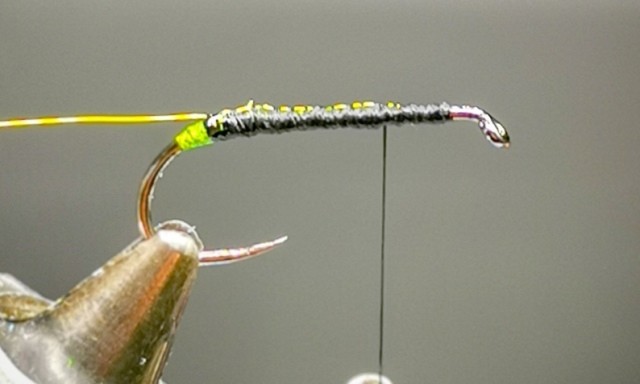
- Tie in Ultrawire and Pheasant Tail. Wrap the body forward and reverse rib it with the wire to the thorax.
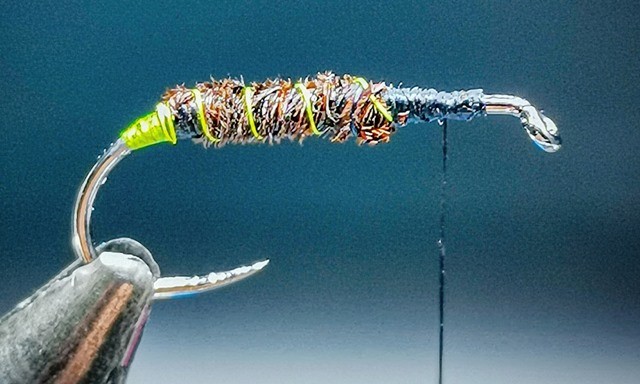
- Tie in 3 strands of Peacock Herl by the tips. Make several wraps building up the thorax and tie off.
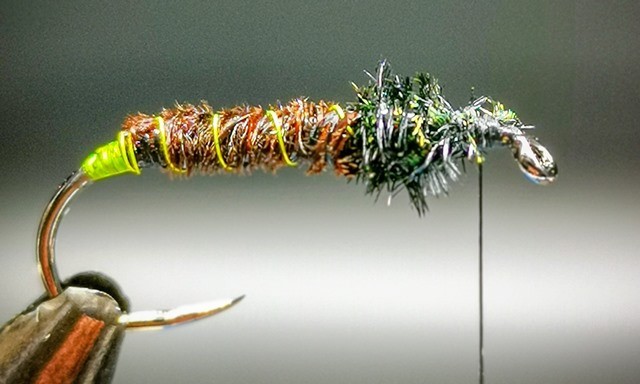
- Select a Grouse feather for the hackle. Tie in by the tip. Make several wraps. Tie off, whip finish, and cure the head with UV Resin.

